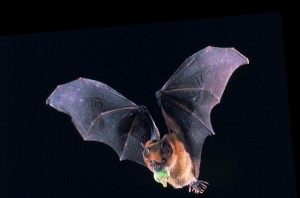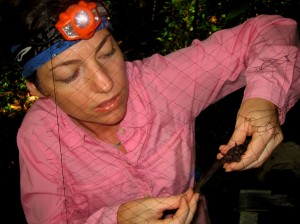Tropical Forests Depend on Bats for Survival
Posted in Science, Shop/Book Reviews on June 2 2009, by Plant Talk
New Book by Garden Scientists Identifies Role in Seed Dispersal
 |
Scott A. Mori, Ph.D., Nathaniel Lord Britton Curator of Botany, specializes in the classification, ecology, and evolution of the Brazil nut family and is especially interested in plant/animal interactions in tropical forests, including the pollination and dispersal of seeds by bats, the subject of his new book recently released by NYBG Press. Scott co-authored Seed Dispersal by Bats in the Neotropics with Botanical Garden post-doctoral fellow Tatyana Lobova, Ph.D. (now an Assistant Professor of Biology at Old Dominion University and an Honorary Curator of the Institute of Systematic Botany of NYBG) and student Cullen Geiselman (doctoral candidate in the joint program of the Department of Ecology, Evolution, and Environmental Biology of Columbia University and the Institute of Systematic Botany of NYBG). |

One of my roles as a scientist at The New York Botanical Garden is to inform policy makers and the general public about the ways in which plants depend upon animals for their survival, because conservation programs that fail to take the co-evolutionary relationships between plants and animals into account are doomed to failure. That, in part, was the purpose for writing Seed Dispersal by Bats in the Neotropics, in which my co-authors and I demonstrate the vital role bats play in maintaining the diversity of plants in New World tropical forests.
Bats are especially important as pollinators of flowers and dispersers of seeds, and this has become increasingly apparent as more and more bat/plant studies are published. In the book we review the role bats play as seed dispersers for the first time since A.L. Gardner’s classic paper on the topic in 1977. We present a literature review of all plants known to be dispersed by bats and all species of bats known to disperse seeds. We also present a summary of our intensive field studies of bat seed dispersal in central French Guiana. Our sampling expeditions took us to disturbed rain forest habitats as well as to some of the most pristine rain forests in the world.

For over five years, we reviewed the literature on Neotropical bat/plant interactions and carried out field trips to French Guiana. Our basic research technique was to capture bats in the same kind of mist nets normally used to catch birds (see photo), hold the bats in numbered cloth bags until they defecated, and then identify the seeds found in the bags by comparing them to seeds represented in herbarium collections. We would look at the specimens of plants we had collected on the same expeditions that we were netting bats (we netted bats at night and collected plants during the day) and would also use the descriptions and images of seeds we found in the reviewed literature to help us identify the seeds we found in the bats’ feces. Our book includes 32 color plates of seeds that we demonstrated to be dispersed by bats, and this will be useful to help other researchers identify fruits and seeds regardless of where in the Neotropics they are carrying out their studies.
We report that 15% of the native flowering plant species known from central French Guiana may rely on bats to disperse their seeds. The majority of these plants (77%) are small-seeded species that pass through the digestive systems of bats while 22% possess larger seeds not ingested by bats. In the latter case, the bats usually carry the fruit away from the parent plant to a night roost where they eat the pulp and drop the large seeds under their roosts. In some cases, the bats drop the fruits while in flight to the night roosts.
Seed Dispersal by Bats in the Neotropics also supports the findings of other bat biologists that secondary forests (i.e., forests that regenerate after either natural or human-induced disturbance) harbor greater numbers of individuals of fewer species of bats than are found in old-growth forests (i.e., forests that have not had major disturbance for at least several hundred years), which harbor more species of bats but fewer individuals per species. This general trend in tropical forests apparently holds true no matter what groups of organisms are being considered—bats, birds, insects, trees, etc.—and emphasizes the need to conserve old-growth forests to protect the greatest number of species. (See my previous blog post on this topic.)
The most common species sought after by bats for food in the New World tropics belong to the plant families Piperaceae (Pepper Family), Araceae (Aroid or Philodendron Family), Cyclanthaceae (Cyclanth or Panama Hat Family), Solanaceae (Potato Family), Moraceae (Mulberry Family), and Clusiaceae (Mangosteen Family). Based on the features of these families, we made the following generalizations about the preferred plant foods of bats. In most cases, bat-dispersed plants: are members of the largest plant families in the New World tropics, have wide geographical distributions, produce abundant fruit crops year-round, rely on bats as their main dispersal agents, possess easy-to-handle (i.e., small, soft, unprotected) fruits with multiple seeds or numerous separate fruits with a single seed, and have small seeds or fruits that impose little constraint on bats in terms of swallowing, gut passage, and ballast.
The utility of this book for the study of plant/animal interactions is summarized by Dr. Theodore Fleming, a leading bat biologist known for his studies of all aspects of bat ecology, who states “This is clearly a landmark study and will be a major reference work for students of Neotropical bats and plants for a long time. The overall level of scholarship is excellent, the literature coverage is exhaustive, and attention to detail and writing are exemplary. I’m particularly impressed with the attention to detail that this group of botanists has paid to bat taxonomy and biology.”
My co-authors and I, however, point out that our book should be viewed as just another step in the understanding of plant/animal interactions in the tropics. The seeds and fruits of most of the plants we report to be eaten by bats are relatively easy for scientists to collect and identify because they are found intact in the feces of bats. On the other hand, we want to make it clear that there are many other plants dispersed by bats that are not yet documented because evidence documenting them is found in feces only as amorphous and difficult-to-identify pulp. To discover what these species are, we suggest developing a DNA bar code library for all species of plants known to be potentially dispersed by bats and using that database to compare DNA found as pulp in feces of captured bats with the DNA library to enable future researchers to identify what other species depend on bats for the dispersal of their seeds. This technique will surely add many other species of plants to the list of known bat-dispersed species and will reveal that bats are even more essential for maintaining tropical plant diversity than currently reported in our book.
We hope that Seed Dispersal by Bats in the Neotropics will allow others to go even further with studies that document the vital role bats play in the survival of plants in tropical forests, and will serve as a reminder that plant conservation also depends on protecting the animals that pollinate their flowers and disperse their seeds.
Seed Dispersal by Bats in the Neotropics ($70 plus shipping and handling) can be purchased by calling 718.817.8721 or by downloading an order form from NYBG Press and faxing it to 718.817.8842.


An excelent resume of what i have heard the best resource on plant-bat interactions. Bats are key frugivores and dispersers in the neotropics and they frequently go unnoticed.